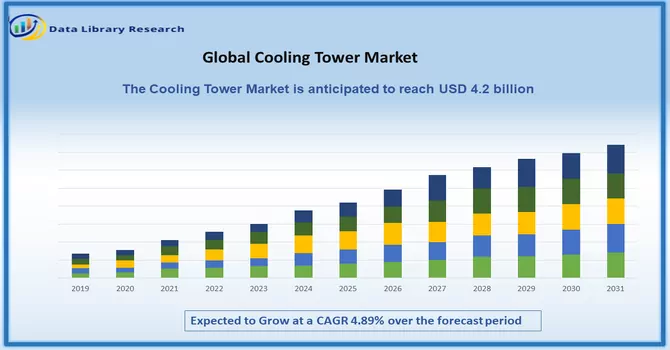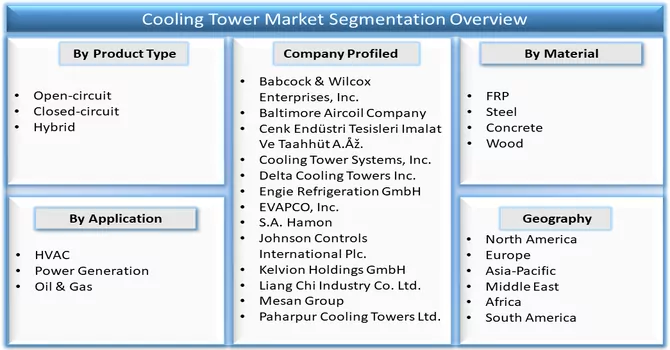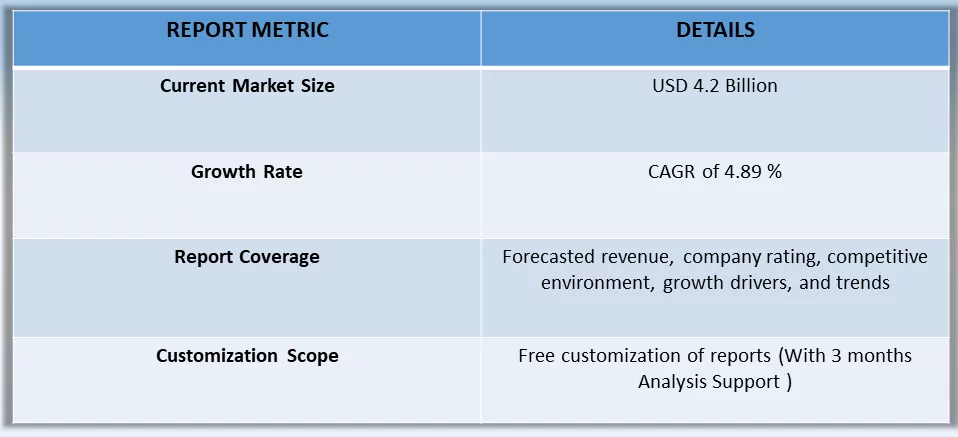The global cooling tower market size was estimated at USD 4.2 billion in 2023 and is expected to expand at a compound annual growth rate (CAGR) of 4.89% from 2024 to 2031.

Get Complete Analysis Of The Report- Download Free Sample PDF
A cooling tower is a specialized heat exchanger that removes heat from a building or industrial process by transferring it to the atmosphere. It does this through the process of evaporation, where a small portion of the water being cooled is evaporated into a moving air stream, which lowers the temperature of the remaining water. Cooling towers are commonly used in HVAC systems to remove heat from chillers and in industrial processes such as power plants, oil refineries, and chemical plants to cool various liquids and gases.
Stringent environmental regulations imposed by governments, particularly regarding emissions and pollution control, are expected to be key drivers for the demand for cooling towers in the foreseeable future. Industries such as power generation and chemical processing, which are known for producing plumes that can impact the environment, are increasingly turning to cooling towers to mitigate these effects. Moreover, in large commercial buildings like office complexes, airports, hospitals, and hotels, HVAC systems play a crucial role in maintaining a comfortable indoor environment. These systems rely on cooling towers to efficiently dissipate heat and maintain optimal temperatures. The growing number of commercial construction projects worldwide, along with the increasing adoption of HVAC systems, is expected to fuel the demand for cooling towers in the coming years. Thus, the combination of environmental regulations, the need for efficient cooling in industrial processes, and the growth in commercial construction projects is likely to drive significant growth in the cooling tower market.
Market Segmentation: The Cooling Tower Market is Segmented by Product (Open-circuit, Closed-circuit, Hybrid), Material (FRP, Steel, Concrete, Wood), Application (HVAC, Power Generation, Oil & Gas), and Geography (North America, Europe, Asia-Pacific, South America, and Middle-East and Africa).

For Detailed Market Segmentation - Download Free Sample PDF
The cooling tower market is experiencing several key trends. Firstly, there is a strong emphasis on energy efficiency, driving demand for more efficient cooling tower designs and materials. Secondly, there is a growing focus on sustainability, leading to the development of eco-friendly cooling tower solutions. Additionally, the integration of smart technology and IoT in cooling towers is on the rise, enabling remote monitoring and optimization of performance. Modular and compact designs are also gaining popularity, particularly in urban areas where space is limited. Stringent environmental regulations are further driving the adoption of advanced cooling tower technologies. Lastly, the market is seeing consolidation and expansion into emerging markets, such as Asia-Pacific and Latin America, which offer significant growth opportunities. Overall, these trends are shaping the future of the cooling tower market, driving innovation and efficiency across various industries.
Market Drivers:
Increasing industrial activities worldwide
The increasing industrial activities worldwide are driving the demand for cooling towers across various sectors. Industries such as power generation, manufacturing, petrochemicals, and food processing rely heavily on cooling towers for efficient heat dissipation.With industrialization expanding in regions like Asia-Pacific, Middle East, and Africa, the demand for cooling towers is expected to rise significantly. These regions are witnessing rapid infrastructure development and urbanization, leading to an increased need for cooling solutions to support industrial processes and commercial buildings. Moreover, the adoption of stringent environmental regulations globally is further fueling the demand for cooling towers. Companies are increasingly investing in sustainable and energy-efficient cooling solutions to comply with these regulations and reduce their carbon footprint. Thus, the increasing industrial activities worldwide are driving the growth of the cooling tower market, with a focus on energy efficiency, sustainability, and compliance with environmental regulations being key drivers.
The need to comply with environmental regulations regarding water usage, discharge, and emissions
The need to comply with environmental regulations regarding water usage, discharge, and emissions is a major factor influencing the design and operation of cooling towers. Water usage is a critical issue, especially in regions facing water scarcity. Cooling towers must be designed to minimize water consumption through efficient cooling processes and the use of water-saving technologies such as drift eliminators and water reuse systems. Additionally, regulations regarding water discharge aim to minimize the environmental impact of cooling tower operations. Cooling towers must comply with strict guidelines for the quality of water discharged back into the environment, often requiring the use of filtration and treatment systems. Emissions from cooling towers, including particulate matter and volatile organic compounds (VOCs), are also regulated to reduce air pollution. Cooling tower manufacturers must design systems that minimize emissions through efficient combustion processes and the use of advanced air pollution control technologies. Thus, compliance with environmental regulations is driving the development of innovative cooling tower technologies that are more efficient, sustainable, and environmentally friendly. This trend is expected to continue as governments worldwide strengthen regulations to protect the environment and public health.
Market Restraints:
High Initial Cost
The high initial cost of cooling towers is a significant factor that can slow down the growth of the market. Cooling towers require a substantial upfront investment for purchase, installation, and maintenance, which can be a barrier for some potential buyers, especially for smaller businesses or in regions with budget constraints. Additionally, the total cost of ownership of a cooling tower includes not just the initial cost, but also ongoing operational costs such as energy consumption, water treatment, and maintenance. These costs can add up over time, further impacting the affordability of cooling towers for some users. However, it's important to note that while the initial cost of cooling towers may be high, they offer long-term benefits such as energy efficiency, reduced water consumption, and lower maintenance costs compared to alternative cooling solutions. As awareness of these benefits grows and as technologies continue to improve, the high initial cost may become less of a barrier, leading to continued growth in the cooling tower market.
The COVID-19 pandemic has had a mixed impact on the cooling tower market. On one hand, the pandemic has led to disruptions in supply chains, delayed projects, and reduced industrial activity, which have affected the demand for cooling towers. Many industries, such as manufacturing, hospitality, and commercial real estate, experienced slowdowns or shutdowns, leading to a temporary decrease in the demand for cooling towers. On the other hand, the pandemic has also highlighted the importance of maintaining healthy indoor environments, particularly in buildings where people gather. This has led to an increased focus on HVAC systems, including cooling towers, to ensure proper ventilation and air quality. As businesses and facilities look to reopen safely, there may be an increased demand for cooling towers to upgrade existing systems or install new ones to meet health and safety guidelines. Furthermore, the pandemic has accelerated trends such as remote work and e-commerce, which could impact the demand for cooling towers in commercial buildings and data centers. With more people working from home and shopping online, the need for cooling in office buildings and retail spaces may change, potentially affecting the demand for cooling towers in these sectors. Thus, while the COVID-19 pandemic has presented challenges for the cooling tower market, it has also created opportunities for growth, particularly in sectors that prioritize indoor air quality and ventilation. As the world continues to navigate the pandemic, the long-term impact on the cooling tower market will depend on how these trends evolve.
Segmental Analysis:
Open circuit segment is expected to witness significant growth over the forecast period
The open circuit segment is expected to witness significant growth over the forecast period, as an open circuit cooling tower is a crucial component in industrial and HVAC systems, utilizing the natural process of evaporation to efficiently cool water. This type of cooling tower exposes water to the air, allowing a portion of it to evaporate and carry away heat, thereby lowering the overall temperature of the remaining water. Open circuit cooling towers are widely used in various industries for their effectiveness in dissipating heat from processes and equipment, ensuring optimal performance and efficiency. Thus, owing to such benefits, the segment is expected to witness significant growth over the forecast period.
The Fiber-reinforced polymer (FRP) Segment is expected to witness significant growth over the forecast period
The Fiber-reinforced polymer (FRP) cooling towers is expected to witness significant growth over the forecast period, as they offer several advantages over traditional cooling tower materials like wood, concrete, or metal. One key advantage is their durability and resistance to corrosion, which makes them ideal for use in harsh environments where exposure to chemicals or saltwater is common. FRP cooling towers are also lightweight, making them easier to install and transport compared to heavier materials. Additionally, FRP is a good insulator, which helps in maintaining the temperature of the cooling water. This can lead to energy savings and increased efficiency. Furthermore, FRP cooling towers are often more cost-effective in the long run due to their low maintenance requirements and long service life. Thus, owing to such benefits, the segment is expected to witness significant growth over the forecast period.
Power Generation Segment is expected to witness significant growth over the forecast period
The cooling towers play a crucial role in power generation plants by dissipating excess heat generated during the electricity production process. In power plants, steam turbines are used to generate electricity, and these turbines require a constant and efficient cooling system to maintain their operational temperature. Cooling towers remove the heat absorbed by the circulating water from the condenser and reject it to the atmosphere through the process of evaporation. This allows the water to be recirculated back to the condenser, completing the cooling cycle. Cooling towers are thus essential in maintaining the efficiency and reliability of power generation plants, ensuring optimal performance and longevity of the equipment. Thus, owing to such benefits, the segment is expected to witness significant growth over the forecast period.
North America Region is expected to witness significant growth over the forecast period
North America is a significant market for cooling towers, driven by various factors including industrialization, urbanization, and the need for efficient cooling solutions in commercial and industrial sectors. The region's diverse industries, including power generation, manufacturing, petrochemicals, and HVAC, rely heavily on cooling towers for heat dissipation. One of the key drivers for the cooling tower market in North America is the stringent environmental regulations regarding water usage, discharge, and emissions. Companies in the region are required to comply with these regulations, leading to a demand for more efficient and sustainable cooling tower solutions. Moreover, the region's focus on energy efficiency and sustainability is driving innovation in the cooling tower market. Manufacturers are developing advanced cooling tower technologies that reduce water consumption, minimize emissions, and optimize energy efficiency. Another trend in the North American cooling tower market is the growing adoption of modular and compact designs, especially in urban areas where space is limited. These designs offer flexibility in installation and maintenance, making them attractive to a wide range of applications. Thus, North America's strong industrial base, coupled with its focus on sustainability and regulatory compliance, makes it a key region for the growth of the cooling tower market.

Get Complete Analysis Of The Report - Download Free Sample PDF
The analyzed market exhibits a high degree of fragmentation, primarily attributable to the presence of numerous players operating on both a global and regional scale. The competitive landscape is characterized by a diverse array of companies, each contributing to the overall market dynamics. This fragmentation arises from the existence of specialized solution providers, established industry players, and emerging entrants, all vying for market share. The diversity in market participants is underscored by the adoption of various strategies aimed at expanding the company presence. On a global scale, companies within the studied market are strategically positioning themselves through aggressive expansion initiatives. This often involves entering new geographical regions, targeting untapped markets, and establishing a robust global footprint. The pursuit of global expansion is driven by the recognition of diverse market opportunities and the desire to capitalize on emerging trends and demands across different regions. Simultaneously, at the regional level, companies are tailoring their approaches to align with local market dynamics. Regional players are leveraging their understanding of specific market nuances, regulatory environments, and consumer preferences to gain a competitive edge. This regional focus allows companies to cater to the unique needs of local clientele, fostering stronger market penetration. To navigate the complexities of the fragmented market, companies are implementing a range of strategies. These strategies include investments in research and development to stay at the forefront of technological advancements, mergers and acquisitions to consolidate market share, strategic partnerships for synergies, and innovation to differentiate products and services. The adoption of such multifaceted strategies reflects the competitive nature of the market, with participants continually seeking avenues for growth and sustainability. In essence, the high fragmentation in the studied market not only signifies the diversity of players but also underscores the dynamism and competitiveness that drive ongoing strategic maneuvers. As companies explore various avenues for expansion, the market continues to evolve, presenting both challenges and opportunities for industry stakeholders.
Some of the key market players are:
Recent Development:
1) In June 2023, Johnson Controls International Plc. has partnered with Accenture to inaugurate two new OpenBlue Innovation Centers in Bangalore and Hyderabad, India. These centers are set to accelerate the development of building control systems and services. This collaboration is poised to drive growth in the cooling tower market by fostering innovation in building automation and control systems, including those related to cooling towers. By leveraging Accenture's expertise in technology and Johnson Controls' leadership in building efficiency solutions, the centers aim to develop advanced cooling tower technologies that enhance performance, efficiency, and sustainability. This initiative is expected to lead to the creation of cutting-edge cooling tower solutions that meet the evolving needs of the market, driving further adoption and growth in the industry
2) In February 2023, Baltimore Aircoil Company (BAC) unveiled its latest innovation, the TrilliumSeries Adiabatic Cooler. This cooling tower is specifically designed for applications requiring high energy efficiency and minimal water usage. Its innovative design optimizes both water and energy efficiency, resulting in cost savings for users. Additionally, the TrilliumSeries Cooler is engineered for easy installation and maintenance, further enhancing its appeal. This advancement is expected to significantly contribute to the growth of the cooling tower market by offering a highly efficient and cost-effective solution for various cooling applications.
Q1. What was the Cooling Tower Market size in 2023?
As per Data Library Research the global cooling tower market size was estimated at USD 4.2 billion in 2023.
Q2. At what CAGR is the Cooling Tower market projected to grow within the forecast period?
Cooling Tower Market is expected to expand at a compound annual growth rate (CAGR) of 4.89% over the forecast period.
Q3. What segments are covered in the Cooling Tower Market Report?
By Product, By Application and Geography these segments are covered in the Cooling Tower Market Report.
Q4. Which region has the largest share of the Cooling Tower Market? What are the largest region's market size and growth rate?
North America has the largest share of the market. For detailed insights on the largest region's market size and growth rate request a sample here.
Data Library Research are conducted by industry experts who offer insight on industry structure, market segmentations technology assessment and competitive landscape (CL), and penetration, as well as on emerging trends. Their analysis is based on primary interviews (~ 80%) and secondary research (~ 20%) as well as years of professional expertise in their respective industries. Adding to this, by analysing historical trends and current market positions, our analysts predict where the market will be headed for the next five years. Furthermore, the varying trends of segment & categories geographically presented are also studied and the estimated based on the primary & secondary research.
In this particular report from the supply side Data Library Research has conducted primary surveys (interviews) with the key level executives (VP, CEO’s, Marketing Director, Business Development Manager and SOFT) of the companies that active & prominent as well as the midsized organization
FIGURE 1: DLR RESEARH PROCESS

Extensive primary research was conducted to gain a deeper insight of the market and industry performance. The analysis is based on both primary and secondary research as well as years of professional expertise in the respective industries.
In addition to analysing current and historical trends, our analysts predict where the market is headed over the next five years.
It varies by segment for these categories geographically presented in the list of market tables. Speaking about this particular report we have conducted primary surveys (interviews) with the key level executives (VP, CEO’s, Marketing Director, Business Development Manager and many more) of the major players active in the market.
Secondary ResearchSecondary research was mainly used to collect and identify information useful for the extensive, technical, market-oriented, and Friend’s study of the Global Extra Neutral Alcohol. It was also used to obtain key information about major players, market classification and segmentation according to the industry trends, geographical markets, and developments related to the market and technology perspectives. For this study, analysts have gathered information from various credible sources, such as annual reports, sec filings, journals, white papers, SOFT presentations, and company web sites.
Market Size EstimationBoth, top-down and bottom-up approaches were used to estimate and validate the size of the Global market and to estimate the size of various other dependent submarkets in the overall Extra Neutral Alcohol. The key players in the market were identified through secondary research and their market contributions in the respective geographies were determined through primary and secondary research.
Forecast Model
